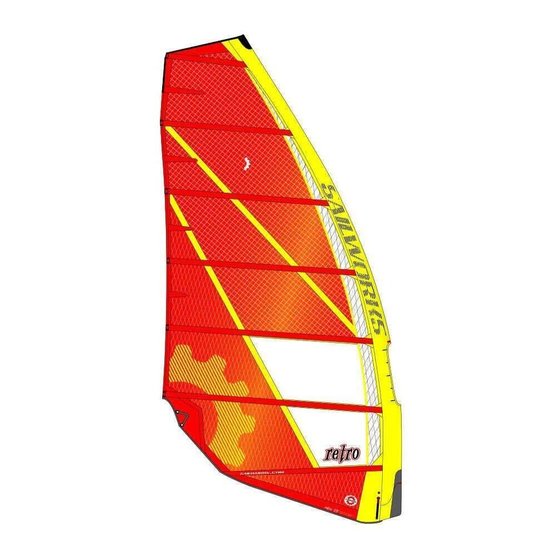
Advertisement
T R O U B L E S H O O T I N G
Problem:
"I keep getting slammed forward; the sail seems to pitch me to the front of my board."
Solution:
• Move the mast step forward to give more leverage over the rig.
• Pull the downhaul more, or pull a bit on the outhaul to stabilize the sail shape better.
Problem:
"I can't pull the downhaul very far."
Solution:
• Check the mast requirements printed on the sailbag; your mast maybe too stiff or too
long for the sail.
• Make sure the downhaul lines are not crossed through the pulley.
• Make sure your line diameter isn't too thick or too worn.
• Try using a tool (easy-rig) to get a better hold on the line.
• Extend the mast base further.
Problem:
"My battens don't rotate very easily."
Solution:
• Check batten tension; excessive batten tension may restrict proper rotation
• Check your downhaul; you may not have enough.
Problem:
"I can't get planing when I know I should be."
Solution:
• Ease the downhaul. Too much downhaul flattens the foil and loosens the leech, which gives
you more control in heavy wind, but less power in light wind. Releasing some downhaul will
move the draft forward and up. This gives more depth and more power in lighter wind.
• Ease the outhaul. Too much outhaul will flatten the sail and take power away, which is
good for high wind control but bad for light wind power.
Problem:
"My Back arm gets tired and I am having a hard time sheeting in.
Solution:
• Your over powered, you may need a harness line adjustment or add some outhaul to move
the draft forward. An extreme downhaul setting and very little outhaul moves the draft back
causing you to use your back arm more to compensate..
Problem:
"My front arm gets tired and I feel like I am going to get launched forward all the time.
Solution:
• Check your harness line balance point; when you are hooked in, see if you can lift your
hands off the boom. If the sail moves to the front or the back of the board, try moving
your lines the other way. Or try to increase your downhaul tension (moving the draft back)
and do not touch the outhaul (It automatically gets looser by pulling the downhaul.
Increasing the outhaul would move your draft forward). This is where you can really relate
the two settings and find the perfect balance.
Quick Rigging Guide
• Roll out sail • Slide mast in • Check headcap is seated properly and mast is fully joined
• Look at conditions - light or strong wind?
• Downhaul to maximum setting and ease up to your setting according to conditions
• Attach boom • Outhaul to suit conditions • Check batten tension
• Go Rip!
S A I L
• Let your sail dry before de-rigging.
• Shake the sand off before rolling up your sail at the beach, as this will extend your sail's life considerably.
Rinse the sail with fresh water occasionally, including inside the mast sleeve, to avoid salt and sand buildup.
• Avoid rigging on hard or abrasive surfaces.
• If left rigged all day or overnight, release the outhaul and downhaul.
• Store your rigged sail out of direct sunlight. UV degrades monofilm.
• To prevent creases in the monofilm, roll your sail on the tube it came on, or roll it tightly and store it where it won't
get flattened.
• Repair tears promptly through a qualified sail repairperson. Make temporary repairs to the
monofilm with Mylar packing tape or a sticker on both sides.
• Do not use solvents for cleaning near seams, as this will dissolve the seam tape
adhesives. Use water and mild soap.
• When on the beach, secure your sail from blowing away.
• Avoid getting sand or dirt inside the mast sleeve and batten pockets.
This reduces sail performance by increasing friction and wear on the mast.
• Loosen the batten tension if you are not going to use the sail for an extended period.
7
PRINTED IN CANADA • COPYRIGHT: SAILWORKS INC. 1997 • DESIGN: BRIDGEWORKS • PHOTOGRAPHY: GREG GRIFFITHS, PIERRE RINGUETTE
M A I N T E N A N C E
Advertisement
Table of Contents

Summary of Contents for Sailworks RETRO
- Page 1 This reduces sail performance by increasing friction and wear on the mast. • Loosen the batten tension if you are not going to use the sail for an extended period. PRINTED IN CANADA • COPYRIGHT: SAILWORKS INC. 1997 • DESIGN: BRIDGEWORKS • PHOTOGRAPHY: GREG GRIFFITHS, PIERRE RINGUETTE...
- Page 2 The mast acts quite literally as the backbone of the rig and it governs the sail’s performance. The mast requirements for the RETRO are printed on the sailbag and at the tack of your sail. The future (and past) is NOW! Listed on page 1 is a broader range of mast specifications (length and stiffness) necessary for...
- Page 3 The optimum downhaul setting gives a tight luff and a lean (not full) entry, and the leech which facilitates early planing. area between the top two battens should become loose (see RETRO Settings Chart). A good reference point is the curved leech seam between the top two battens. If the looseness falls High wind (over-powering conditions) short of this seam from the leech side, you will have the minimum setting.
- Page 4 You can expand the Retro’s wind range significantly by adjusting the downhaul and outhaul. IMPORTANT: Downhaul and outhaul tension are closely interrelated. Whenever you pull or ease the downhaul, you inversely affect the outhaul tension, so readjustment of the outhaul may be required.



Need help?
Do you have a question about the RETRO and is the answer not in the manual?
Questions and answers